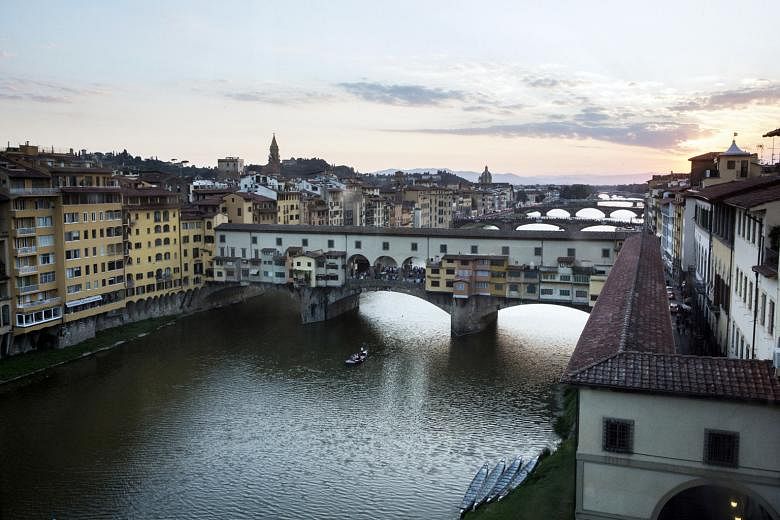FLORENCE (ITALY) • Mr Eike Schmidt, the new director of the Uffizi Gallery here and the first non-Italian to hold the job, took what seemed like a logical step. In the spring, he set up loudspeakers warning visitors about scalpers and pickpockets who target tourists waiting in the perennially long lines outside Italy's most-visited museum, famous for its magnificent treasures by Botticelli and Raphael.
But not everyone was grateful. A few days later, three Florence police officers with media in tow handed him a fine of about US$329 (S$443) for broadcasting without proper city authorisation.
"Initially, I was a little bit angry," Mr Schmidt, a German art historian, said recently. But he quickly spotted an opportunity, telling them he would pay the fine out of his pocket. The next day, when he did, journalists were there snapping photos, making him an instant celebrity.
Florentines began approaching him on the street to express their support. "Some initially said, 'Don't stop. Finally, someone takes these problems seriously,'" he said. "There are other people who try to give me money," he added with a laugh.
Once seen as a naive foreigner, he had earned public respect. The clashing reactions to the loudspeaker experiment point to a fundamental challenge he faces.
As he fights to manage the crowds, generate more revenue and improve the museum experience - including its chaotic ticketing system and long lines - will he continue to marshal popular support and prevail against a morass of bureaucratic restraints, vested interests and political intrigue?
"It's like playing multiple chess games at the same time," he said.
Last year, the Uffizi, Pitti Palace and Boboli Gardens merged into one entity, and 3.4 million people visited, resulting in €17.3 million (S$23.2 million) in ticket revenue for the state, making it the most profitable museum in Italy.
Mr Schmidt's goal is to improve the museum's flow; oversee a building renovation; reorganise the administration; rationalise a haphazard exhibition schedule; foster serious scholarship; rewrite wall labels; and find innovative ways to showcase a collection that has more than 12,000 paintings, 3,500 ancient sculptures, and 180,000 prints and drawings, including works from Latin America, collected over the centuries but rarely shown.
The 48-year-old was hired last year from his job as a curator at the Minneapolis Institute of Art as part of a sweeping reform that gave 20 Italian institutions greater autonomy from the Culture Ministry in Rome, which funds and staffs them.
In what was perceived as a bold move, the ministry opened directorships, for the first time, to an international search, eventually hiring seven non-Italians. Mr Schmidt, a scholar of the Medici collection that formed the basis of the Uffizi, had lived in Florence in the past.
The reform, advanced by the culture minister, Mr Dario Franceschini, was intended to bring in fresh talent and give these "super museums" - including the Capodimonte in Naples, Pinacoteca di Brera in Milan and Accademia in Venice - more control over their budgets, exhibitions and services such as cafes and bookshops, to become more self-sustaining at a time when Italy's economy is stagnating.
The question facing Mr Schmidt - Can Italy change? - is the same one facing Prime Minister Matteo Renzi, 41, a former mayor of Florence who is deeply invested in the museum's fate. He came to power in 2014 promising reform, but now sees growing resistance. Creating the autonomous museums is a key part of his legacy. Both are in play, if not in jeopardy.
I observed the challenges up close one day in June when I attended a staff meeting with Mr Schmidt.
He was discussing how to open to the public one of the museum's most prized features, a corridor designed by Giorgio Vasari, the 16th-century Italian artist and author. It is open only to tours run by private companies which often profit more than the museum does.
The Vasari Corridor begins inside the Uffizi, once the Medici seat of government, in an area damaged by a Mafia bomb in 1993, and traverses the Arno River via the top floor of the Ponte Vecchio, Florence's famed 1345 bridge. The end point is the Pitti Palace, where the Medici once lived and which now houses other museums.
The Uffizi has the world's oldest and largest collection of self- portraits, Since the 1970s, the corridor has been lined with more than 700 of them. There are Annibale Carracci's portrait of himself on a canvas on an easel and ones by Titian, Delacroix, Ingres, Sargent, Morandi, even Rauschenberg, up to the present day.
Most visitors never get to see them and Mr Schmidt also worries about their condition. In the corridor, he said, "they get deep-fried in summer and deep-frozen in winter". But how to adapt Renaissance architecture for mass tourism?
Italy has pledged €58 million to double the Uffizi's exhibition space by converting offices into galleries, and to build a new exit for better flow. Mr Schmidt hopes to move the paintings to a space in the Uffizi with climate control and to display Greek and Roman inscriptions that are less sensitive in the corridor, allowing visitors to cross from one museum to the other.
But with change comes resistance. Last month, a prominent Italian architect who serves on the Uffizi's advisory committee, Mr Stefano Boeri, said in the media that he did not want to remove portraits from the corridor for aesthetic reasons.
After Mr Schmidt announced in March that the hallway would close for renovations this fall, a union organiser filed a complaint, saying that if the corridor was not up to code, it should close immediately. The fire department shut it down, but later said it could reopen on a limited basis until renovations begin.
"I'm fighting for it," Mr Schmidt said of his plan to open the corridor to visitors.
NEW YORK TIMES


